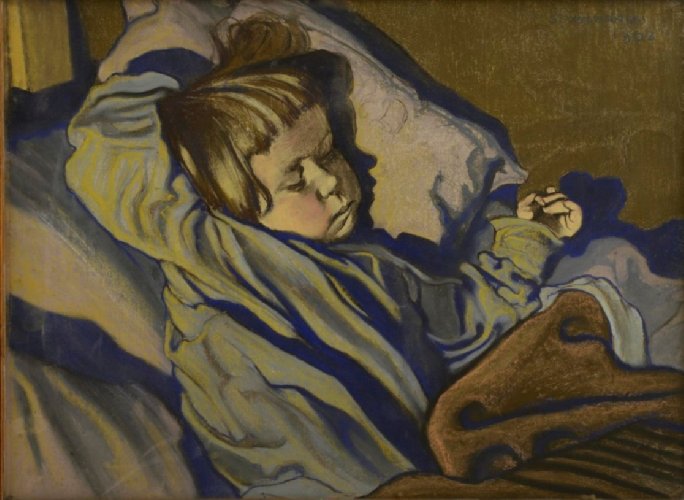Description:
Stanisław Wyspiański (1869-1907) had a major influence on the formation of his original and recognizable style of art, which was shaped by his studies with Jan Matejko in Krakow, his travels, and a several year stay in Paris with his friend, Józef Mehoffer. He was particularly impressed by his exposure to the works of Van Gogh, Gauguin, and Toulouse Lautrec while in Paris. Sensitive to oil painting, he began to use mainly pastels. In addition to painting, he was involved in graphic design, decorative polychromy, stained glass design, theatrical staging, interior and furniture design, poetry and plays. His art, which fits into the program of Young Poland, is described as symbolic, expressionistic and Art Nouveau.
Description of painting:
In a harsh, artificial light, amidst folds of blankets, shirts and bodysuits lies a boy, deep in sleep. His arms are spread out limply, the blanket discarded, and part of his neatly trimmed, blonde hair has fallen onto the pillows. The light penetrates the composition, almost illuminating it with a yellow hue, creating sharp, navy shadows. One of them creates the reflection of the boy’s profile on the light pillow. We see the portrait from above, as if we were leaning over the child’s bed together with his father.
Unaware of being portrayed, Mietek, Wyspiański’s three-year-old son, has probably just uncovered himself in his sleep. The yellow light may also suggest the proximity of a source of heat, such as a fireplace. The portrait is so suggestive that one gets the feeling that the child’s chest will soon rise lightly, and a faint sound of breathing will be heard. On the plump face, there is a faint blush, thick eyelashes cover the eyes, and under the round nose, the lips are curved in a bow.
As is the case with most of Wyspiański’s paintings of children, the artist here uses a narrowed composition, creating an intimate, chamber-like world. The dreamy scene is enlivened and diversified by the decorative, very contrasting colours of the folds forming the bedding, cover and pillow, as well as the nightshirt of the small model. The gesture of the widely spread arms also introduces dynamics to the peaceful scene.
Wyspiański often portrayed his nearest and dearest. From getting to know Teodora Teofila Pytko, coming from the village of Konary near Tarnów, among the great projects there also appear intimate images of his beloved in colourful, folk costumes. In time, Wyspiański began to capture the images of his four children too, most often in pastels on paper. From dozens of paintings, drowsy, bored, and sometimes even grumpy little ones look out, painted with a father’s sensitivity and tenderness. Wyspiański liked to observe his models for longer before making the first, quick and flawless lines. This technique was more difficult with the lively children, who were not afraid of the mustached painter, as he was their father. To observe his offspring, Wyspiański had to take advantage of the time when they were peacefully sleeping.


